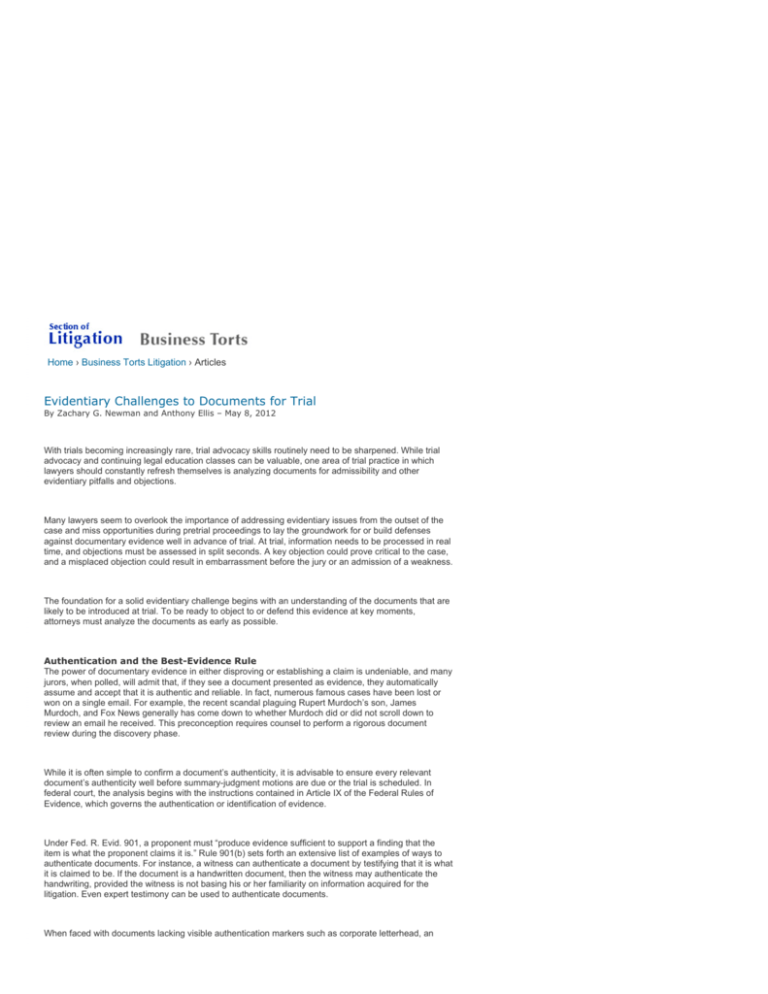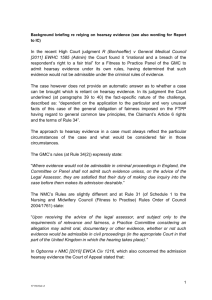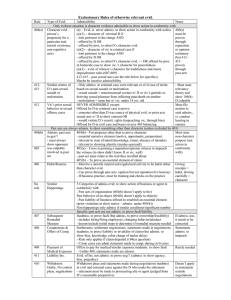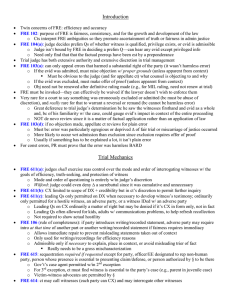
Home › Business Torts Litigation › Articles
Evidentiary Challenges to Documents for Trial
By Zachary G. Newman and Anthony Ellis – May 8, 2012
With trials becoming increasingly rare, trial advocacy skills routinely need to be sharpened. While trial
advocacy and continuing legal education classes can be valuable, one area of trial practice in which
lawyers should constantly refresh themselves is analyzing documents for admissibility and other
evidentiary pitfalls and objections.
Many lawyers seem to overlook the importance of addressing evidentiary issues from the outset of the
case and miss opportunities during pretrial proceedings to lay the groundwork for or build defenses
against documentary evidence well in advance of trial. At trial, information needs to be processed in real
time, and objections must be assessed in split seconds. A key objection could prove critical to the case,
and a misplaced objection could result in embarrassment before the jury or an admission of a weakness.
The foundation for a solid evidentiary challenge begins with an understanding of the documents that are
likely to be introduced at trial. To be ready to object to or defend this evidence at key moments,
attorneys must analyze the documents as early as possible.
Authentication and the Best-Evidence Rule
The power of documentary evidence in either disproving or establishing a claim is undeniable, and many
jurors, when polled, will admit that, if they see a document presented as evidence, they automatically
assume and accept that it is authentic and reliable. In fact, numerous famous cases have been lost or
won on a single email. For example, the recent scandal plaguing Rupert Murdoch’s son, James
Murdoch, and Fox News generally has come down to whether Murdoch did or did not scroll down to
review an email he received. This preconception requires counsel to perform a rigorous document
review during the discovery phase.
While it is often simple to confirm a document’s authenticity, it is advisable to ensure every relevant
document’s authenticity well before summary-judgment motions are due or the trial is scheduled. In
federal court, the analysis begins with the instructions contained in Article IX of the Federal Rules of
Evidence, which governs the authentication or identification of evidence.
Under Fed. R. Evid. 901, a proponent must “produce evidence sufficient to support a finding that the
item is what the proponent claims it is.” Rule 901(b) sets forth an extensive list of examples of ways to
authenticate documents. For instance, a witness can authenticate a document by testifying that it is what
it is claimed to be. If the document is a handwritten document, then the witness may authenticate the
handwriting, provided the witness is not basing his or her familiarity on information acquired for the
litigation. Even expert testimony can be used to authenticate documents.
When faced with documents lacking visible authentication markers such as corporate letterhead, an
examination should be conducted with the appropriate witness as to the genuineness of the document.
Issues concerning the authenticity of documents can also be addressed in interrogatories or requests to
admit. Often, simple questions such as “How do you know that?” or “Do you personally know that?”
during depositions reveal critical information as to the witness’s base of knowledge. Attorneys should
consider maintaining spreadsheets that set forth each exhibit, identify its method of authentication, and
list any evidentiary objections that may arise.
Certain documents are self-authenticating, such as domestic public documents that are officially sealed
and signed. Fed. R. Evid. 902(1). Domestic public documents not sealed but signed and certified may
also be admissible under Rule 902(2). Foreign public documents may be self-authenticating as well,
provided the document is signed or attested to by a person who is authorized by the foreign country and
the document is accompanied with a final certification in accordance with Rule 902(3). This process can
be time consuming and should be implemented early during the discovery phase, especially given that
adversaries are afforded a reasonable opportunity to investigate the document’s authenticity and
accuracy. Rule 902 enumerates many other self-authenticating documents, such as official publications,
newspapers, periodicals, trade inscriptions, commercial paper, and certified records of a regularly
conducted activity.
Often, lawyers attempt to introduce the contents of certain documents through oral testimony and run
afoul of what is known as the best-evidence rule. Under this rule:
[A] party seeking to prove the “content” of a writing must introduce the “original” or a “duplicate” of the
original, unless it is established that (1) all originals have been lost or destroyed (absent bad faith by
the proponent); (2) the original cannot be obtained; (3) the original is in the possession of an opposing
party who refuses to produce it; or (4) the writing is not closely related to a controlling issue.
Fed. R. Evid. 1004.
The original writing, recording, or photograph is “required in order to prove its content unless [the
Federal Rules of Evidence] or a federal statute provides otherwise.” Fed. R. Evid. 1002. Events can still
be proved by nondocumentary evidence, even though a written record of it was made. “If, however, the
event is sought to be proved by the written record, the rule applies.” Fed. R. Evid. 1002 Notes of
Advisory Committee on Proposed Rules. For example, an employee’s salary can be proved without
producing the written wage documents, but if the issue concerns whether the employee signed the back
of his paycheck, the actual check will likely be required. Pierre R. Paradis, “The Celluloid Witness,” 37
U. Colo. L. Rev. 235, 249–51 (1965). “On occasion, however, situations arise in which contents are
sought to be proved. Copyright, defamation, and invasion of privacy by photograph or motion picture
falls in this category.” Fed. R. Evid 1002 Notes of Advisory Committee on Proposed Rules.
Under Fed. R. Evid. 1003, duplicates are admissible to the same extent as originals unless a “genuine
question is raised about the original’s authenticity or the circumstances make it unfair to admit the
duplicate.” Fed. R. Evid. 1003; see, e.g., Myrick v. United States, 332 F.2d 279, 282 (5th Cir. 1964)
(no error in admitting photostatic copies of checks instead of original microfilm in absence of suggestion
to trial judge that photostats were incorrect); Johns v. United States, 323 F.2d 421 (5th Cir. 1963) (not
error to admit concededly accurate tape recording made from original wire recording); Sauget v.
Johnston, 315 F.2d 816 (9th Cir. 1963) (no error to admit copy of agreement when opponent had
original and did not on appeal claim any discrepancy).
What if the originals are lost or destroyed through no fault of the offering party? Under Rule 1004, a
party may introduce other evidence of the content of a writing, recording, or photograph if the original
was lost or destroyed; the original cannot be obtained by any available judicial process; the party against
whom the original would be offered had control of the original, was notified that the original would be
offered, and failed to produce it at the trial; or the writing, recording, or photograph is not closely related
to a controlling issue. Under Rule 1005, a copy of public records is admissible, provided the record is
otherwise admissible and the copy is certified as correct in accordance with Rule 902(4) or is testified to
be correct by a witness who has compared it with the original. Rule 1007 also permits the proponent to
prove the content of a writing, recording, or photograph by the testimony of the party against whom the
evidence is offered. In a jury trial, the jury determines in accordance with Rule 104(b) any issue about
whether the asserted writing ever existed, another one produced at trial is the original, or other evidence
of content accurately reflects the content.
Relevancy and Prejudice
Under Fed. R. Evid. 401, evidence is deemed relevant if it tends to make a fact more or less probable
than it would be without the evidence and the fact is of consequence in determining the action.
“Relevancy is not an inherent characteristic of any item of evidence but exists only as a relation between
an item of evidence and a matter properly provable in the case. Does the item of evidence tend to prove
the matter sought to be proved ?” Fed. R. Evid. 401 Notes of Advisory Committee on Rules.
Generally, all relevant evidence is admissible unless another “evidentiary rule or law provides
otherwise.” Pease v. Lycoming Engines, 2012 U.S. Dist. LEXIS 6354, at *4 (M.D. Pa. Jan. 19, 2012)
(citing Fed. R. Evid. 402; Daubert v. Merrell Dow Pharms., 509 U.S. 579, 587 (1993) (noting that the
“[b]asic standard of relevance under the Federal Rules of Evidence is a liberal one.”)). Courts will
exclude relevant evidence “if its probative value is substantially outweighed by the danger of unfair
prejudice, confusion of the issues, or misleading the jury, or by considerations of undue delay, waste of
time, or needless presentation of cumulative evidence.” Fed. R. Evid. 403.
However, exclusion is viewed as an extreme remedy, and many courts refrain from excluding evidence
at the pretrial stage and defer the decision until trial and with the benefit of having the record fully
developed. Fed. R. Evid. 403; In re Paoli R.R. Yard PCB Litig., 916 F.2d 829, 859 (3d Cir. 1999).
Should counsel have questions about the admissibility of any evidence, the best practice may be to file a
motion in limine to address deficiencies in documents or test their admissibility at the time of trial.
Partial Documents and Out-of-Context Testimony
Counsel should be vigilant in determining whether a document being offered into evidence is a complete
document and whether it would be advantageous to introduce the entire document. Often this situation
arises when only excerpts of emails are introduced.
An adverse party has the right to require the introduction of any other part or any other writing or
recorded statement “that in fairness ought to be considered at the same time.” Fed. R. Evid. 106. This
rule prevents parties from taking concepts or facts out of context, and the trial judge has considerable
discretion in deciding whether the introduction of the balance of the document or other documents
should be addressed on cross-examination or later in the trial.
Settlement Negotiations
Documents that reveal settlement negotiations are generally inadmissible to prove liability for, the
invalidity of, or the amount of a disputed claim. Fed. R. Evid. 408(a). Nor can they be used to impeach
through a prior inconsistent statement.
Settlement negotiations could be admitted, however, to show bias or prejudice, or to negate a contention
of undue delay. Fed. R. Evid. 408(b). Thus, in one case, although the plaintiff was permitted to introduce
the settlement negotiations to negate the defendant’s laches defense, the plaintiff was not allowed to
introduce the negotiations to negate an expected defense of the defendant until the record was more
fully developed. Pandora Jewelers 1995, Inc. v. Pandora Jewelry, LLC, 2011 U.S. Dist. LEXIS
62969, at *32 (S.D. Fla. June 7, 2011).
Permissible Impeachment and Bias
Throughout the pretrial proceedings, lawyers must be watchful for documents that can be used to
impeach trial witnesses or demonstrate bias. These types of documents may not even appear to be
admissible at first, but they could be used to discredit or contradict testimony. This type of evidence
becomes critical during cross-examinations.
For example, the general rule in most jurisdictions is that references to the wealth or poverty of a party
are not permitted. Brough v. Imperial Sterling Ltd., 297 F.3d 1172, 1178 (11th Cir. 2002). However,
evidence concerning a financial incentive in the outcome of an action could be admitted on crossexamination to show witness bias. Crowe v. Bolduc, 334 F.3d 124, 131–32 (1st Cir. 2003); Pandora
Jewelers, 2011 U.S. Dist. LEXIS 62969, at *35. Thus, cross-examination usually will permit additional
opportunities to admit documentary evidence or to use documents to impeach the witness, such as
under Fed. R. Evid. 613. “When examining a witness about the witness’s prior statement, a party need
not show it or disclose its contents to the witness. But the party must, on request, show it or disclose its
contents to an adverse party’s attorney.” Fed. R. Evid. 613(a).
Often, a litigant may be able to overcome an objection to extrinsic evidence merely by offering to permit
the witness to explain away the prior inconsistent statement. “Extrinsic evidence of a witness’s prior
inconsistent statement is admissible only if the witness is given an opportunity to explain or deny the
statement and an adverse party is given an opportunity to examine the witness about it, or if justice so
requires.” Fed. R. Evid. 613(b). Notably, this rule does not apply to an opposing party’s statement as an
admission under Rule 801(d)(2).
Hearsay
Documents must also be carefully reviewed for hearsay pitfalls and objections. This analysis begins with
Article VIII of the Federal Rules of Evidence. Hearsay is a statement that the declarant does not make
while testifying at the current trial or hearing and a party offers in evidence to prove the truth of the
matter asserted in the statement. Fed. R. Evid. 801. Rule 801(d) identifies two categories that are not
hearsay. The first is a declarant witness’s prior statement, provided the statement is inconsistent with the
testimony and was given under penalty of perjury. The statement also can be consistent with the
testimony but offered to rebut a charge that the declarant “recently fabricated it or acted from a recent
improper influence or motive in so testifying.” Fed. R. Evid. 801(d)(1)(B). An opponent’s statement that is
offered against the opponent and was made by the opponent or someone authorized to make the
statement also is not hearsay. Fed. R. Evid. 801(d)(2).
Counsel should evaluate each document and all expected testimony for hearsay challenges. This
evaluation begins with the 23 exceptions to the hearsay rule set forth in Fed. R. Evid. 803, which
includes present sense impressions, excited utterances, and then-existing mental or physical conditions.
The most common exceptions utilized in business litigation are recorded recollection, business records,
public records, and reputation concerning character. In addition, counsel can always resort to the
residual exception contained in Fed. R. Evid. 807, which allows a trial court to admit hearsay if the
statement has “equivalent circumstantial guarantees of trustworthiness,” is offered as evidence of a
material fact, is more probative on the point for which it is offered than any other evidence the proponent
could obtain through reasonable efforts, and admitting the statement serves the purposes of the Rules
of Evidence and the interests of justice. Most courts, however, construe the residual exception narrowly.
The business-records exception to hearsay is perhaps the most litigated exception in the businesslitigation community. Under Fed. R. Evid. 803(6), hearsay is admitted if it can be established as a record
or a regularly conducted activity. This is a record of an act, an event, a condition, an opinion, or a
diagnosis, provided that five factors can be established. First, the record must have been made at or
near the time by or from information transmitted by someone with knowledge. Second, the record must
have been kept in the course of a regularly conducted business activity. Third, making the record had to
be a regular practice of that activity. Fourth, all these conditions need to be shown by testimony of the
custodian or another qualified witness or with approved certifications permitted by state statute or that
complies with Rule 902(11). Finally, there must not be any indication of a lack of trustworthiness.
Business records should be subjected to heightened scrutiny during pretrial preparation and discovery.
For example, some courts have precluded portions of business records that included an employee’s
conclusions or opinions, as they were beyond what was considered to be the regularly conducted
activity. Pandora Jewelers, 2011 U.S. Dist. LEXIS 62969, at *37; Citizens Fin. Grp., Inc. v.
Citizens Nat’l Bank of Evans City, 383 F.3d 110, 121–22 (3d Cir. 2004) (upholding district-court
ruling to exclude log entries that reflected “the thought process, conclusion, analysis or interpretation” of
the employee who filled out the entry); Vitek Sys., Inc. v. Abbott Labs., 675 F.2d 190, 194 (8th Cir.
1982) (excluding handwritten memorandum of employee’s meeting with customer as evidence of
confusion because such evidence would elicit employee’s evaluation of customer’s thought process, and
such testimony “does not fall within the present sense impression exception to the hearsay rule”).
Certain entries of the business record may still be admissible, for example, if the business record itself or
some other exception can be applied. See, e.g., University of Ga. Athletic Ass’n v. Laite, 756 F.2d
1535, 1546 (11th Cir. 1985) (admitting as evidence of actual confusion an affidavit from a professor who
stated that he received inquiries in person or by telephone about an infringing mark); Popular Bank of
Fla. v. Banco Popular de Puerto Rico, 9 F. Supp. 2d 1347, 1360 (S.D. Fla. 1998) (testimony by
switchboard operator about misdirected calls due to confusion about trademark owner was admissible
under “then-existing state of mind” hearsay exception).
With the proliferation of electronic evidence, care must particularly be applied to analyzing the
applicability of the business-records exception. Some courts have found that emails sent casually as a
substitute for a telephone call lacked the requisite regularity for the business-records exception to the
hearsay rule. See, e.g., In re Oil Spill by the Oil Rig “Deepwater Horizon” in the Gulf of Mex.,
2012 U.S. Dist. LEXIS 16847, at *6–8 (E.D. La. Feb. 8, 2012).
Conclusion
Trial lawyers should approach document evaluation as a fluid, inexhaustible process. This mindset will
allow lawyers to best leverage their clients’ position through either the admission or exclusion of
documentary evidence.
Keywords: litigation, business torts, pretrial practice, document evaluation, evidence, best-evidence
rule
Zachary G. Newman is a partner and Anthony Ellis is a senior associate with Hahn & Hessen LLP in New York,
New York. Yoon-jee Kim, a first-year law clerk with the firm, assisted in the preparation of this article.
Copyright © 2012, American Bar Association. All rights reserved. This information or any portion
thereof may not be copied or disseminated in any form or by any means or downloaded or stored
in an electronic database or retrieval system without the express written consent of the
American Bar Association. The views expressed in this article are those of the author(s) and do
not necessarily reflect the positions or policies of the American Bar Association, the Section of
Litigation, this committee, or the employer(s) of the author(s).
Reprinted with permission.











